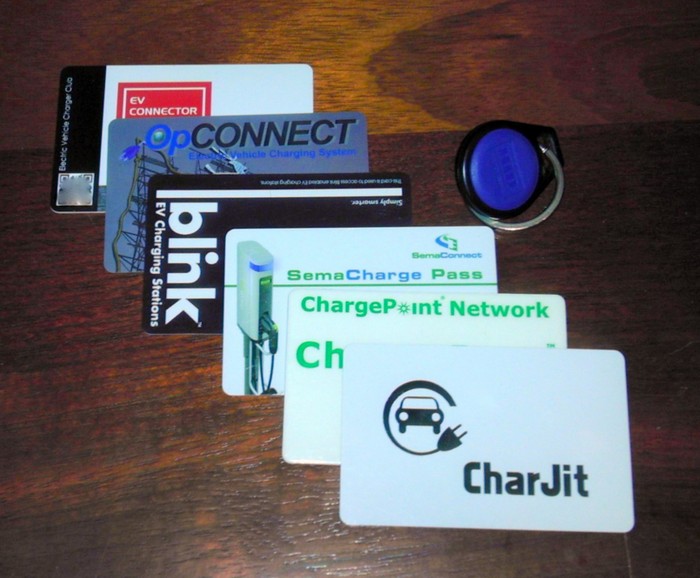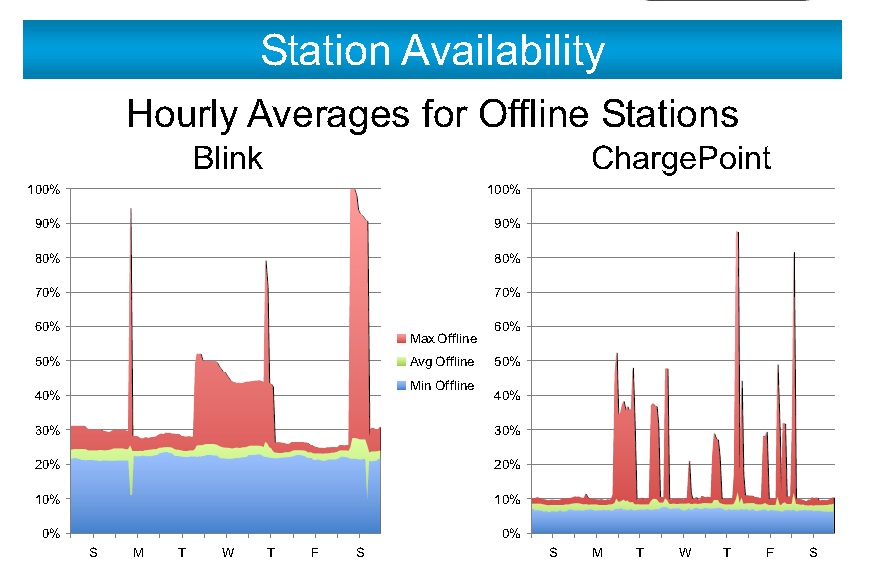
Electric-car charging network cards, photo by Patrick Connor, Portland
Remember the early days of mobile phones, when lots of small carriers competed and roaming was just a far-distant dream?
Welcome to the wild world of electric-car charging, folks.
Right now, more than a dozen networks--some local, some regional, some national--operate Level 2 charging stations for plug-in cars.
Each has a separate membership process, varying rate plans, and a unique card or touch-tag that's incompatible with any other network.
Confusion? In spades.
Nonetheless, informed plug-in drivers know some networks are better than others.
Most importantly, some networks are more reliable than others--defined by whether a charging station is actually working (able to deliver a charge) when a driver arrives.

Availability of electric-car charging stations from Plug-In America study, May 2012
Now, Tom Saxton of Plug-In America has quantified the likelihood that charging stations within the Blink and ChargePoint networks will be working at any given time.
His study was based on polling live data feeds from the individual charging stations--available online--every five minutes, and looking at uptime versus downtime and how long any given station stayed offline.
The results were startling.
Almost 25 percent of Blink network stations were offline at any given time. The comparable figure for ChargePoint network stations was 10 percent.
And while two-thirds of ChargePoint's offline stations were restored to working order within an hour, 46 percent of offline Blink stations remained that way for more than a day--and a further 14 percent for more than a week.
Saxton presented the study, Are Taxpayer and Private Dollars Creating Effective Electric Vehicle Infrastructure?, at last week's 26th annual Electric Vehicle Symposium in Los Angeles.
A more graphic summary of the results was also displayed as a poster. The study covered the period January through April of this year.
Of course, issues other than uptime distinguish different charging groups as well.

Repair time of electric-car charging stations from Plug-In America study, May 2012
Blink Networks, for example, originally had has no provision at all for a non-member to use its charging stations.
While other networks require a membership card, most of them also have a toll-free number printed on the station so a stranded electric-car driver can call and give a credit-card number to obtain a one-time charging session.
Blink doesn't didn't have such a number until "roughly six months ago," according to Scott Watkins, senior manager of communications for Ecotality, which operates the Blink network. It launched in 2010 without the number, he said, and has since added it in response to user feedback.
[UPDATE: We have updated this article after being contacted by representatives for Ecotality, who pointed out that its stations now have a toll-free number on them. In a photo of a Blink station later provided by Ecotality, there is a small black sticker with a toll-free number for "Sales & Support"--mounted on the side of the housing.]
But we suspect that whether a charging station is live and able to deliver charge is the major concern of most electric-car drivers.
And until live data on every charging station's current usage and state of repair is available through an electric car's navigation system, reports like this one will be enormously useful.
Are you listening, Blink?
[UPDATE: "Improving our online performance is out top priority," Ecotality's Watkins said in response to Plug-In America's study.]
+++++++++++












